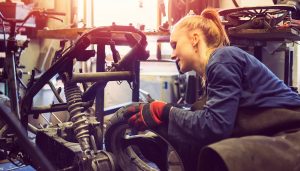
Get your bike in good-running condition before first taking out this season
Motorcycle Maintenance: Get Your Ride Ready for Spring
You’ve got to do a little motorcycle maintenance before you get out there to take advantage of the warm weather.
Nothing is worse than pushing the starter button for your first ride of the season and hearing that sickening click-click-click noise from a dead battery. Or riding five miles out and hearing the engine sputter and cough to a stop because of water and gummy deposits in the fuel system. That’s not good either.
Getting your bike ready for a new riding season is an annual ritual, and it can be fun too. Let’s go over some simple motorcycle maintenance you can do to ensure carefree, safe riding this year. And before you head out, it’s a good idea to go over basic motorcycle safety tips.
Wash Your Bike Carefully
Ever notice that when you do a detailed wash and polish that’s when you discover bolts that are loose and parts that are damaged? Take your time and clean every nook and cranny on the bike. Give it a good inspection as you clean, polish and wax.
Oil and Filter Change
This is one motorcycle maintenance item that everybody who rides can handle on their own. I’ll bet there are YouTube videos about your specific bike that show you exactly how to change your own oil and filter.
While you’re at it, remove and inspect the air cleaner too. Like a vacuum cleaner bag, it will collect an amazing amount of dust and dirt. If it’s too dirty to clean, or if it’s very old, replace it. A clean air filter will improve your fuel mileage, too.
Keep the Tires in Good Shape
You’ll almost certainly need to put some air in the tires. While you’re doing your motorcycle maintenance, reward yourself with a good, high-quality tire pressure gauge. The dial types are more accurate than the cheap pencil-type gauges.
Get one small enough to carry in your bike’s tank bag. You will need it for all those long-distance motorcycle road trips you’re eventually going to take.
What equipment do you carry on your bike to fix a flat tire? At the very least, you should invest in some temporary supplies that would get you to safety when stranded with a flat tire. Buy some radial tire plugs and a cheap installation kit from any auto parts store for $20. They won’t take up much space on your bike.
Get a good pair of diagonal cutting pliers to pull out the nails and screws that tires seem to pick up, and to trim the plugs after you install them.
To inflate the tire after you repair the leak, at the very least carry an aerosol can of automobile tire sealer and inflator, available from your favorite department store for $10. It’s not ideal, but it’s good in a pinch.
Brakes and Fluid
When’s the last time you looked at your brake pads for wear? When is the last time you looked carefully?This is a crucial motorcycle maintenance item, don’t let it slide.
And yes, the fluid has to be replaced every few years. If you’re not confident about doing that yourself, it won’t cost much at a bike shop. Be safe, not sorry, when it comes to brake maintenance on a bike.
Battery and Charging System
If you didn’t remove the battery for winter storage, remove it now. Clean its terminals with a knife, scraping them gently so a shiny layer of lead is exposed for good electrical contact. Use sandpaper to gently buff the cable ends too.
If the battery is low on water, which is actually an acid solution, top it off with distilled water.
How old is your battery? If it is nearing the end of its warranty, consider replacing it now, especially if your bike does not have a kick starter.
Bulbs and Lenses
Bulbs do burn out, and they are simple to replace. Check each one. Turn signal and brake light lenses crack from age and will leak water into the light assembly. Look at each one.
When installing any new light bulb, apply a thin coat of dielectric grease to the contact terminals, to ward off corrosion.
Fuel System
Gasoline doesn’t last forever. After 6o days of storage it starts slowly decomposing back into crude oil. Along the way, it produces gummy deposits that clog all the tiny passages inside the bike’s carburetors or fuel injection system. That will make your bike hard to start or sputter to a stop on the open road.
That’s why it is a great idea to add fuel stabilizer to your bike’s gas tank before you place it into long winter storage. The stabilizer slows down the fuel’s decomposition process.
Water in the fuel will settle to the lowest components, the carburetors, which have drain screws to let the accumulated water out. It should be done once yearly as routine motorcycle maintenance. Your owner’s manual will show you how to do that. It’s easy.
Wash Your Gear
If you have a textile jacket, you can remove the armor pads and wash the jacket in your washing machine. Don’t use bleach, just a good detergent on a warm water setting. Depending on how dirty the jacket is, you might have to run it through two or three wash cycles.
Clean your face shields with warm soap and water. Don’t use glass cleaner, as that will ruin the finish. Is your helmet in good shape? If so, then remove the liner and padding and wash all that in warm soap and water. That makes them smell fresh. Your GoPro motorcycle mount will stick to your helmet better if it’s clean.
This is also a good time to invest in some rain gear if you don’t have any. It will come in handy if you’re riding a motorcycle in the rain.
Legal Stuff
Lastly, don’t store your registration and insurance papers on your bike, especially if you own a model that has a high theft rate. Carry those documents in your wallet.
Be sure all your insurance and registration is up to date before heading out. Ride safe.





